Bicycle Touring Lassen and Plumas National Forests
All content (other than maps) copyright © 2010-2024 Frank Revelo, www.frankrevelo.com, United States copyright office registration number TX-7931345, maps copyright © OpenStreetMap and Frank Revelo
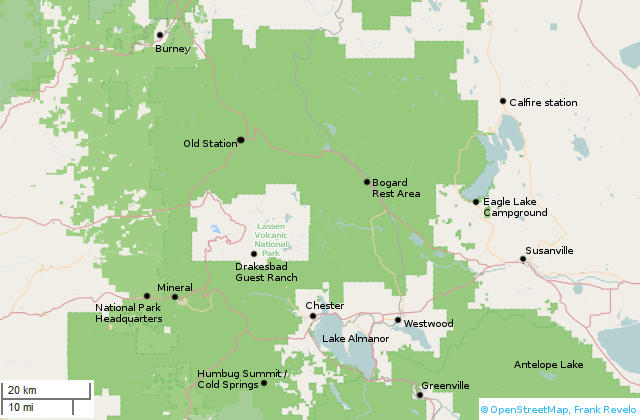
These forests are located in northeast California and are a perfect place to tour in the summer months (June through October). Wide variety of resupply and lodging options in the surrounding towns (Susanville, Chester, Burney), so no need to carry huge amounts of food and possible to clean up in a motel room or campground shower every few days and thus avoiding being filthy all the time. Network of dirt roads means travel along dangerous paved roads can be mostly avoided. Much of the area is covered by national forests, where it is legal to camp anywhere, so long as you follow "leave-no-trace" principles. Please do not make campfires, as the area is prone to wildfires in the dry summer months. The area is easy to reach (via mostly dirt roads) from either Chico to the west or Reno to the east. Though the area is mountainous, it is possible to avoid huge ascents/descents if these don't interest you (other than getting from/to Chico, if that is your starting point, since Chico is near sea level and the Lassen area is between 4000 and 8000 feet for the most part).
Lassen National Park might be considered the centerpiece of a tour in the Lassen area, but I've never had any desire to bicycle highway 89, which is the main road through the park, partly due to the huge ascents/descents involved and partly because of all the tourist traffic. A better idea is highway 312 from Chester to Warner Valley, which has only moderate traffic. About 19 miles one-way, which took me exactly 2 hours pedaling from Chester (slight uphill grade). $5 for National Park entrance fee for solo bicyclists in 2014. Drakesbad Guest Ranch has an excellent buffet lunch ($15 including tax but not gratuity in 2014, which I considered a fair price given the quality and quantity of food I ate). You can then work off some of that lunch by hiking to Boiling Springs and Devils Kitchen (about 6 miles round-trip), which are among the more interesting features in the park. Finally, camp at either the Warner Valley campground or in the forests along highway 312.
Like most of California, the Lassen area has dry summers and wet winters. It would not be unusual to only encounter rain two or three times during the three months of July through September, and even that rain mostly just a light drizzle. Though obviously, you should be prepared for heavier rain during the summer. Since the Lassen Forest is mostly about 5000 feet elevation, most of the wet season precipitation will be in the form of snow, which accumulates during the winter then melts in the spring. Mosquitoes can be a major problem during the spring and early summer. By July, mosquitoes will only be a problem in wet areas (near marshy meadows and lakes), at higher elevations (especially above 7000 feet) where there is more snow and it lingers longer, and an hour or so before sundown and perhaps an hour after dawn. If you stick mostly to the lower and drier areas, and get into a tent or bugbivy an hour before sundown and stay there until an hour or so after dawn, you should have little trouble with mosquitoes from July through September and no trouble in October, when nights start to become cold.
Even at 5000 feet elevation, temperatures can get very hot in the summer, with daytime highs of over 95°F (35°C) and nighttimes lows of over 60°F (16°C) during the heat waves. Pedaling uphill in the sun in heat like this can be exhausting. Be sure to carry plenty of water, and take rest breaks in the shade of the abundant trees. Heat waves alternate with cooler periods of daytime highs of 85°F (29°C) or so and nighttimes lows under 60°F (16°C). Temperatures start cooling down in early September and daytime temperatures typically remain mild through October, with nighttime lows then around or below freezing.
Archery hunting season typically starts in late August, but the bow hunters soon lose enthusiasm when they discover how difficult it is to catch deer with a bow, especially when the hunters use a noisy truck or ATV to reach the area where they will be hunting. Rifle hunting for deer typically begins in late September or early October and lasts for a few weeks. It would be advisable to wear blaze orange when venturing away from the roads during rifle hunting season.
Here is my journal and photos from touring this area in Aug 2012.
Here is my journal and photos from touring this area in July through September 2013.
Here is my journal and photos from touring this area in July through October 2014.
Here is my journal and photos from touring this area in August through September 2015.
Recommended maps and other navigational tools
Pages from the California Road and Recreation Atlas by Benchmark Maps (2010 edition), 1:300,000 scale, with lat/long grid (NAD83 datum), relief indicated by shading and elevation in feet of selected peaks. Cut pages out and trim margins so folded pages fit into 12"x12" Aloksak, so as to protect maps from tearing and prevent them from being blown about by the wind. Hand-write page numbers on the trimmed pages, since the printed page numbers are part of what will need to be trimmed. These are very high-quality maps, certainly much better than the DeLorme and Rand McNally road atlas maps with respect to the network of dirt roads. Scale is too small to use as a primary navigational tool, but very useful for route-planning and for those areas not covered by the forest service maps. Pages 47, 48, 49, 53, 54, 55, 59, 60, 61 from the landscape section cover the entire northeast corner of California (Lake Tahoe on the south, Oregon border on the north, Nevada border to the east, central valley to the west). Unlike with the forest service maps, both public and private roads are shown. However, private roads may be blocked off by fences and gates, or may be abandoned and blocked by fallen trees. So even if a road shown on the map exists on the ground, it may not be usable.
USDA Forest Service map for Lassen National Forest (2012 edition). This map is printed on durable, water-resistant plasticized paper. 1:126,720 scale, lat-long grid every 7.5 minutes (NAD83 datum), plus section grid. Sections were how property was historically divided up in the United States, and typically measure 1 mile on a side, though sometimes there are odd-shaped sections. Based on the fact that a minute of latitude in the Lassen area is slightly more than a mile, and a minute of longitude is slightly less than a mile, it is easy to find which section you are in using lat-long coordinates shown on a GPS device, and that is sufficient accuracy to navigate when staying on roads, dirt or otherwise. (Obviously, a proper UTM grid would be better than this section kludge.) Map shows elevation for selected peaks plus some relief shading, but not nearly as much elevation information as I would like to see. The Lassen map covers all of Lassen National forest and most of Plumas national forest, and so was my primary navigational tool during my 2012 tour. I would say I accessed this map 20 times per day on average, at least when in the area covered by this map. Besides lack of elevation information, the other major deficiency of this map is that it fails to show the entire network of dirt roads, especially dirt roads that are primarily or entirely on private land, even though many of the dirt roads on timber company land are open to bicycle traffic. I purchased this map at REI.
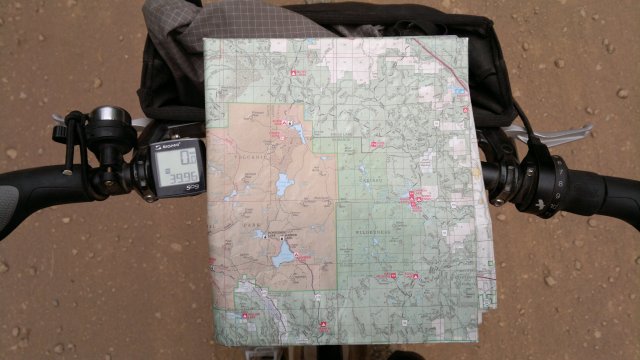
lassen forest service map folded into a square that fits neatly into my handlebar bag, note the section grid
USDA Forest Service map for Plumas National Forest (2001 edition). Printed on regular paper, rather than the plasticized paper used for the Lassen map. Like the Lassen map, 1:126,720 scale with lat-long grid every 7.5 minutes (NAD27 datum) plus section grid. No relief information other than elevation for selected peaks. I carried this map on my first trip to the area but never used it, since most of the area shown is also shown on the Lassen map, plus the Lassen map is more durable and otherwise superior. I did not carry this map on later trips, since I have no special interest in the areas of southern Plumas national forest which it covers but which are not covered by the Lassen map (these southern areas are more mountainous than the northern areas, hence lots of strenuous ascents/descents, plus the network of dirt roads is less dense).
GPS of some sort is essential for finding your position on the paper maps, and a mapping GPS loaded with topo maps is highly advisable. I use the Garmin Etrex 20 loaded with Garmin 1:100,000 topographic maps for the entire United States. The topo information is invariably accurate and will remain accurate. But the road information, obtained from the Census TIGER road database, has many errors with respect to the dirt roads. Supposedly, the Garmin 1:25,000 topo maps have a more accurate road database. The Etrex 20 has a small display, so is cumbersome to use for route-planning. For all these reasons and also because any GPS, like any electronics, can fail in the field, the mapping GPS should be used in addition to paper maps, rather than as a replacement.
Most bike tourists will be carrying a smartphone for voice communication and internet access. It is possible to use the smartphone as a substitute for a dedicated GPS. For example, the Gaia GPS app, which runs on both Android and IOS, supports downloading offline topo maps from a variety of sources and thereby converts a smartphone to an excellent mapping GPS. On the other hand, dedicated outdoor GPSs are typically more rugged and waterproof than smartphones, run on field-replaceable AA batteries rather than requiring a charging system, can be mounted directly on the bicycle handlebars, and having a dedicated GPS plus a smartphone allows the latter to serve as backup in case the former fails. More on the subject of GPS here.
In addition to GaiaGPS (using OpenCycleMapping or other topo maps), I also use the MAPS.ME (OpenStreetMapping maps), Here (Navteq maps), and Sygic (TomTom maps) apps, with the appropriate map data downloaded to the smartphone in advance, so that no network connection is required to use these apps in the field. These other apps are mainly for street mapping in cities, but sometimes are also useful in the backcountry. For example, the Sygic app, when zoomed out, provides a nice 3D terrain overview.
Crude north-south orientation can normally be easily determined from the sun. However, there have been times when I wanted more precise orientation, such as to identify a ranch that was visible 20 miles away across a valley, using a combination of my paper map and my known current position on that paper map. Accuracy of orientation to within about 10 degrees is sufficient for this, so no need for a fancy compass with sighting mirror, just a simple fluid-filled compass with degrees marked on the sides. Declination of magnetic north is between 14 and 15 degrees east of true north in the Lassen area as of 2012.
Getting to the area from Reno
Tahoe-Pyramid bikeway between Reno and Verdi (GPX file here). Henness Pass and Smithneck roads between Verdi and Loyalton. Route A24 plus a short stretch of highway 70 between Loyalton and Beckwourth. Beckwourth Genesee road between Beckwourth and Genesee valley. From there, use Lassen forest service map to navigate, after reading the section on safety below.
There are open forests with flat spots along Henness Pass and Smithneck roads, and then again along Beckwourth Genesee Road at two places. First, a half-mile down a dirt side road heading west, about 5 miles north of Beckwourth, just south of the high point on the Beckwourth Genesee road. Second, about 10 miles north of Beckwourth, just north of the Clover Valley Ranch. The vast Sierra valley is privately owned and fenced cattle grazing land, unsuitable for camping, as is most of Clover Valley other than the patch of forest just noted. North of Clover Valley, the Beckwourth road traverses a steep canyon with no flat spots until the Genesee valley is reached, where there are flat spots along a dirt road, not shown on the forest service map, which runs west between 25N42 and the river, starting just before the Flournoy bridge. The first half-mile or so along this dirt road is forest service land, where camping is legal. After it enters the Heart K ranch, the road is private and day use only. Typically, I make a late start the first day and camp along Smithneck road that night (4 hours riding from Reno), then camp 5 miles north of Beckwourth the second night (4:30 hours riding), then camp along the dirt road in the Genesee valley the third night (3 hours riding). For the fourth night, camp either along the Old Haun road on the way to Chester, or along the road to Westwood. As of 2014, there is a bar with rooms for rent in Loyalton, so a possibility for those who dislike camping is to stay there the first night and then at one of the motels in Greenville the third night (or perhaps the second night if you are willing to make the second day a very long one). Similar considerations as to camping/lodging possibilities apply to returning to Reno.
Getting to the area from Chico
There are two routes on mostly dirt roads, the old Lassen trail route to the west of highway 32, and the Humbug route to the east of highway 32. The Lassen trail route rises to a max of about 5000 feet while the Humbug route rises to almost 7000 feet. Since someone coming from Chico (or elsewhere in central or coastal California) would presumably not be altitude acclimated initially, it would probably be best to use the former route to get to the Lassen area and the latter for returning to Chico. I'll describe both routes as if traveling from downtown Chico to Chester.
Lassen trail route: Cohasset road, 28N29, 27N08, 28N20 to highway 32. Cross highway 32 to a logging road which is not shown on the forest service route. Follow this for about 2 miles to where further progress is blocked by a gate and the road exits to a turnout on highway 36. Follow highway 36 east for about 1.5 miles. See below for photo and discussion of this stretch of highway 36, which is not too dangerous. Turn right (south) onto 28N78, followed by 28N79 and 28N30. Last 3 miles, from the intersection of highways 36 and 89 to Chester, is along highway 36, which has a wide shoulder at this point and hence is not too dangerous.
The descent into and out of Deer Creek canyon is rugged and steep. I had to push for an hour on the ascent. I was traveling from Chester to Chico, but I believe the ascent in the opposite direction would be equivalent in difficulty. Total distance from Chico to Chester will be about 88 miles, with over 7000 feet of ascent and 3000 of descent, and maximum elevation of about 5000 feet. Traveling in the opposite direction took me over 11 hours of pedaling and pushing. Most cyclists will want to split this trip into two days and camp somewhere along the way. I camped on an abandoned logging road near Four Lantern Flat, but there are plenty of other possibilities further to the north. Not so many possibilities south of that point.
Humbug route: Skyway to the Honey run road exit. Decent shoulder on Skyway to this point. Alternatively, there might be a bike path which runs from downtown Chico to the Honey Run road, thus making it possible to avoid Skyway entirely. Honey Run road is quiet. Fork left at the Honey Run covered bridge onto Centerville road, which is very quiet. About a mile past the Centerville museum/school, Centerville road turns to gravel and has little or no traffic until it reaches the Nimshew development, where it becomes paved again. Fork left onto Humbug road, which eventually merges with Skyway. A PG&E campground at this point makes a good location for a rest stop. Skyway is fairly quiet up here, whereas it was a multi-lane expressway back near Chico. Follow Skyway about a mile north, then fork left onto Powellton road (25N16), which is gravel. Powellton road parallels and eventually merges with Skyway about 5 miles to the north. At this point, Skyway is very quiet. Follow Skyway north for another few miles, then fork right onto the Humbug Summit road, aka route 915/13, which soon turns to gravel. Shortly after passing Humbug summit, there is an intersection of gravel roads, which is incorrectly signed, so pay careful attention to the map rather than the road signs. Either continue on the Humbug road (route 307), or take the Yellow Creek road (27N65, 27N04, route 308). Yellow Creek road is almost straight downhill, whereas Humbug road descends into Humbug valley then ascends before descending again, but both routes are scenic. The two roads merge as they approach highway 89. Just before highway 89, turn left (to the north) onto a dirt road (not shown on the forest service map) which parallels highway 89. Last 3 miles, from the intersection of highways 36 and 89 to Chester, is along highway 36, which has a wide shoulder at this point and hence is not too dangerous.
Total distance between Chico and Chester for the Humbug route will be about 77 miles, with over 7000 feet of ascent and 3000 feet of descent, and maximum elevation near 7000 feet. It took me over 11 hours to cover this distance, pedaling the whole way. Most cyclists will want to split this trip into two days and camp somewhere along the way. I camped at a saddle near Gold Hill, after about 36 miles and 5000 feet of ascent, but there are plenty of other places to camp after this point.
Getting to Chico from Sacramento and the San Francisco Bay Area
As of 2012, Amtrak allows bikes on board its trains, but there is only one train per day between Chico and Sacramento and it arrives/departs Chico in the middle of the night. However, there are four Amtrak/Capital Corridor thruway buses that travel between Chico and Sacramento at more convenient hours, and supposedly these will also accept bikes as baggage, provided there is room in the baggage compartment. Ask on one of the bike forums about this.
Finally, it is possible to get to Sacramento from the Bay Area with a bike via Capital Corridor trains. Note, however, that demand for bike storage on Capital Corridor trains is very high.
Safety
One of the best things about touring in the Lassen and Plumas national forests is the possibility of avoiding busy highways for the most part. Note that even when a highway has an excellent hard shoulder and open sightlines (such as highway 70 between Beckwourth and Vinton, see photo below), there is still the possibility of a drunk or distracted driver veering onto the shoulder (or a distracted cyclist veering off the shoulder into traffic). It is thus safest, in my opinion, to avoid being anywhere near fast-moving traffic, which means sticking to dirt roads as much as possible, with quiet paved roads (such as those of the Indian and Genesee valleys) as a next-best alternative.
Suggestions for avoiding busy highways:
- Follow the instructions above for getting to the area from Reno or Chico via mostly dirt roads.
- To get from Taylorsville to Greenville, use routes 212 and 112.
- To get from Greenville to Canyondam, use routes 202 and 201 (old haun road), followed by a mile along route 147. You absolutely want to avoid highway 89 between Greenville and Canyondam (see photo and discussion below).
- To get from Canyondam to Chester, travel 2 miles on highway 89 to the boat ramp exit, then use the Lake Almanor Recreation trail to get to Lake Almanor West, then cross highway 89 to the Humbolt/Humbug road and turn right (north) at the first dirt road, which runs parallel to highway 89 (this dirt road is not shown on the forest service map because it is on private forest company land, but it does exist). The 3 mile stretch of Highway 36 between highway 89 and Chester has a very wide shoulder and so is not particularly dangerous (there is also a dirt road alternative, not shown on the forest service map, but then you have to contend with gravel trucks on this alternative, so I'm not sure it would be safer).
- To get from Chester to the Bizz Johnson trail and thus to Susanville, take route 318 (Juniper Lake road), then 28N12 (take left fork or "M" line, since right fork or "L" line leads to Last Chance Campground), then 32N10 aka route 10, then 30N07 until this intersects the Bizz Johnson trail.
- Route A21 is quiet between Bizz Johnson trail and Westwood, in case you want to visit the latter.
Places where travel on a busy highway might be required:
- Downtown Reno to Verdi along the Tahoe Pyramid bike route. Most of this route is along dedicated bike trails or quiet suburban streets. The few highway sections are not particularly dangerous, though it will be necessary to pay attention to the rear view mirror. Widely used bike route by Reno area bicyclists.
- Downtown Chico along Skyway to the Honey Run road exit. I believe there is a bike path to avoid this stretch of Skyway. In any case, Skyway has a good shoulder up to this point (after this point, the shoulder disappears).
- One mile on route 147 between the Old Haun Road (route 201) and Canyondam. Photo and discussion below.
- Two miles on Highway 89 between Canyondam and the southern end of the Lake Almanor Recreation Trail. There is a 3 foot shoulder, so I didn't find this stretch to be seriously dangerous. It is certainly nothing like the stretch of highway 89 between Greenville and Canyondam.
- Two miles on Highway 36 to get from Chester to where the Lassen Trail (forest service road 28N20) exits from highway 32, since 28N81 is blocked by a locked gate. Photo and discussion below.
- Two miles on highway 36 to get from Susanville to the Eagle Lake road (route A1). A good hard shoulder and open sight lines, so not particularly dangerous. I prefer to take a roundabout route to Eagle lake, using the Bizz Johnson trail, then route 101, route 112, Merrill Flat road and finally two miles along paved route A1.
- 5 stretches of about a mile each, to get between Burney and Chester via the west and south of the National Park: (a) mile or so on highway 299 west from Burney to route 4M001, aka the Tamarack Road; (b) mile along highway 44 between 32N17 and 31N17; (c) mile along highway 36 between 31N17 and west end of highway 172, which is a very quiet paved road; (d) half-mile between east end of highway 172 and 29N25A/28N88; (e) 50 yards on highway 32 between 28N88 on west side and a dirt road just north of the bridge on the east side, which then runs parallel to 36 for several miles; (f) the same two miles on highway 36 described above to get from this dirt road to 28N78. Photos and discussion below.
- About about mile on highway 89 to get between Doty Road (shown as 6R200 on the forest service map) and route 34N76, which is the start of a dirt road route to Burney. Photos and discussion below.
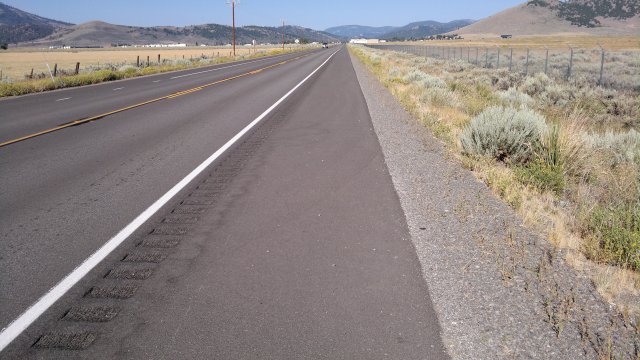
Highway 70 east of Beckwourth. Hard shoulder is smooth, almost 8 feet wide, and with rumble strip separating shoulder from traffic lanes. If only all paved roads had shoulders like this!
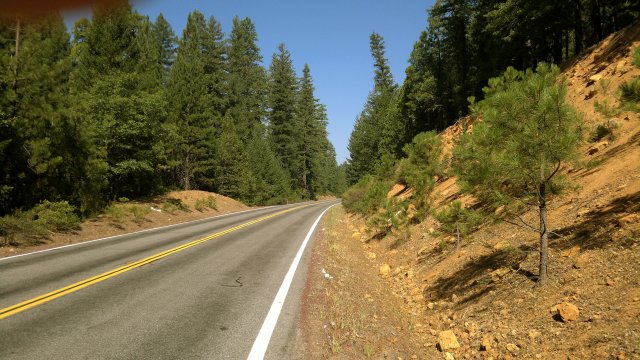
Highway 89 between Greenville and Canyondam. Frequent blind curves, no hard shoulder, soft shoulder sloped to form a ditch and also extremely soft and thus likely to cause skidding and falling back onto the road, perhaps right under the wheels of a big truck. This 5 mile stretch requires about 1000 feet of elevation gain, so stretches of more than 5% grade. Loaded touring bicycles will thus be moving slowly at times and possibly wobbling from side to side, while motor vehicles will be passing at 60+ mph. Photo was taken early on a Sunday morning, but there was already moderate traffic then. I was in a rush to get off this road and so neglected to include traffic in the photo (same reason the photo is partly obscured by my finger). Normally, traffic is very heavy. All in all, an extremely dangerous road for bicyclists.
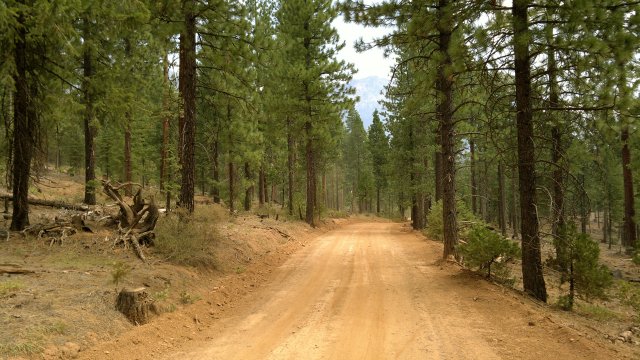
Old Haun Road. This is the peaceful dirt road alternative to the extremely dangerous stretch of highway 89 between Greenville and Canyondam. You'll be lucky to be see any cars/trucks on this road and those you do see will be moving very slowly. Only disadvantage is an extra 300 feet of elevation gain (1300 feet total versus about 1000 feet for highway 89).
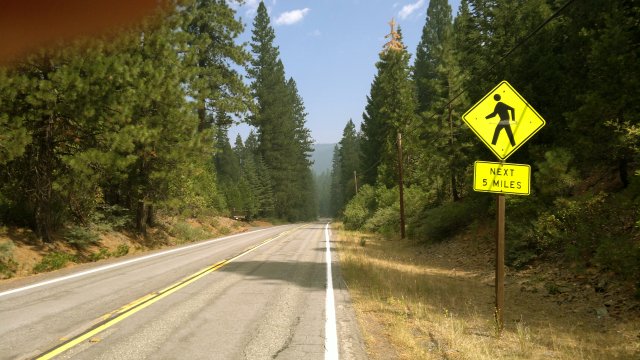
Route 147, which runs north along east side of Lake Almanor, from Canyondam to Westwood. Alternative to taking the Recreation trail along the west side of Lake Almanor to get from Canyondam to Chester. No hard shoulder, but at least no blind curves, only moderate traffic and soft shoulder not so soft as to cause easy skidding (assuming you have fat tires and are not traveling too fast). Also, as the sign suggests, there is considerable pedestrian movement across this road, due to being lined with vacation houses and RV parks on both sides in many places, so trucks at least tend to drive carefully and not too fast.
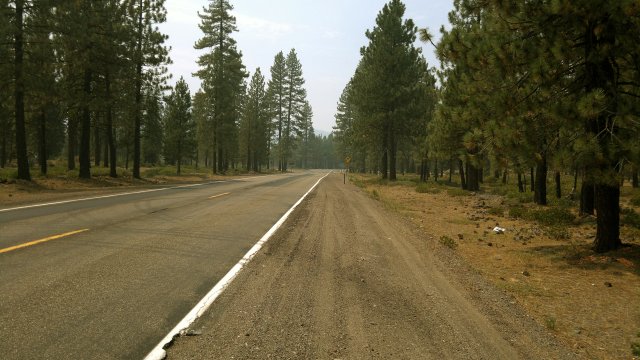
Highway 36 west of Chester. No hard shoulder, but also no blind curves and soft shoulder not so soft as to cause easy skidding. So just go slow and move carefully onto soft shoulder in case of heavy traffic. One mile on highway 36 is required to get between Chester and the intersection of 28N20 (the old Lassen trail) and highway 32. Forest service map shows 28N81 as a way to avoid highway 36, but that road is blocked by a locked gate. So follow 28N78 to highway 36, then highway 36 west for about a mile, past the St Bernard Lodge and various houses, to where highway 36 makes a sharp bend right (to the north) and there is a turnout. Here it is possible to get back onto a dirt logging road (not shown on the map), which parallels highway 36 the rest of the way to highway 32.
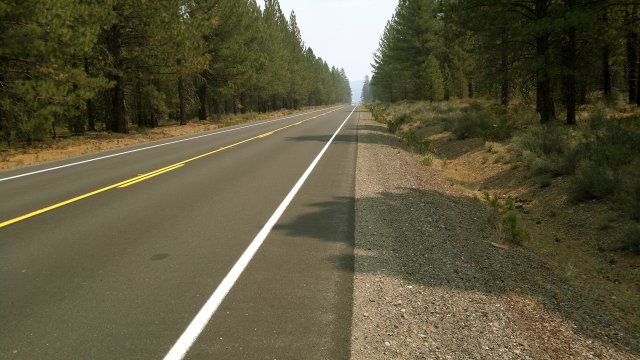
Highway 44 near Poison Lake. Adequate shoulder and open sight lines, but I see no reason to travel on a highway when there are dirt road alternatives.
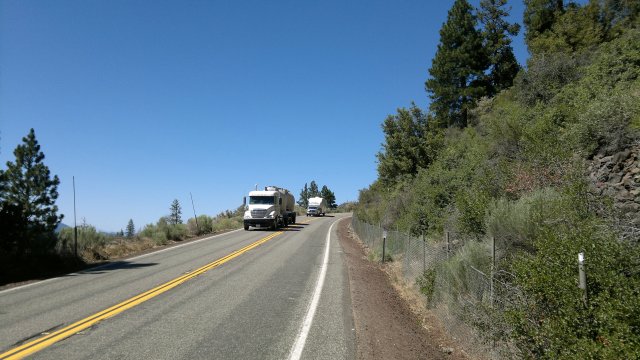
Highway 44 east of Old Station. Two miles of highway necessary between dirt roads at top and bottom of escarpment (Hat Creek Rim). The mile closest to Old Station has adequate shoulder and is not too dangerous, but the mile of steep ascent/descent is extremely dangerous: minimal hard shoulder, soft shoulder is a ditch, blind curves, heavy truck and RV traffic, very steep so that descending trucks cannot slow down, hence potential squeeze situations (trucks in both lanes, no room for bicycle, descending truck moving at high speed doesn't see bicycle until last minute due to blind curve and can't slow down in any case, thus bicycle must pay very close attention to rear view mirror and be prepared to stop and push bike into ditch to get out of the way). Because this dangerous stretch of highway is the only route between the plateau and Old Station, I recommend using Burney rather than Old Station as the resupply point for touring in the western part of the Lassen National forest.
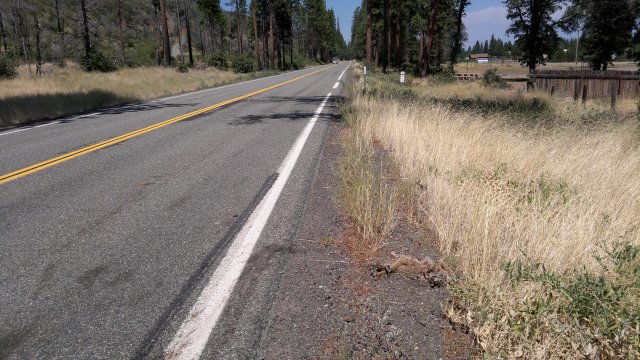
Highway 89 at Doty Road (6R200 on the Forest service map). Less than a mile of highway necessary to get between Doty Road and route 34N76, which is the start of a dirt road route to Burney. Flat and with open sight lines, no hard shoulder, but okay soft shoulder and moderate traffic. All in all, moderately dangerous. If you feel unsafe, just get off and walk this stretch. If pedaling, it will take about 5 minutes at 10mph. As long as you keep checking the rear view mirror during this 5 minutes, you should be okay. Failure to pay attention could cause you to end up like the fawn lying on the soft shoulder towards the bottom center of the photo. A highway patrolman and a worker at the radio observatory both remarked that a touring bicyclist had been hit and killed near here recently.
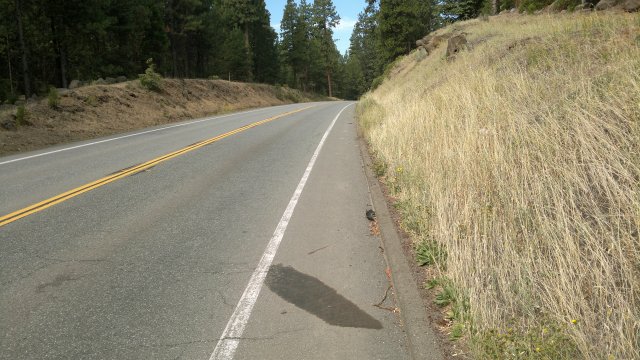
Highway 299 west of Burney. About a mile of highway between Burney and route 4M001, aka the Tamarack Road. Adequate hard shoulder, hence low danger.
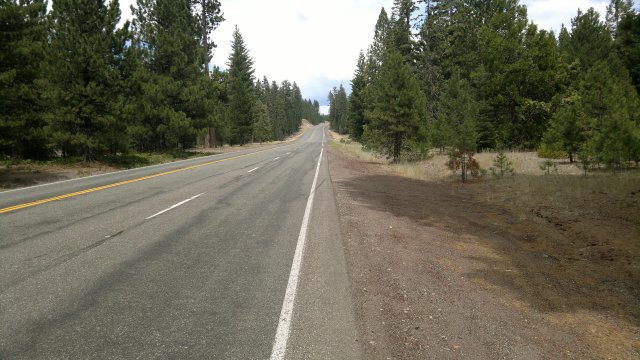
Highway 44 west of Lassen National Park. About a mile of highway necessary between 32N17 and 31N17. Wide soft shoulder and open sightlines, hence low danger. Ride or push on the soft shoulder if you feel unsafe.
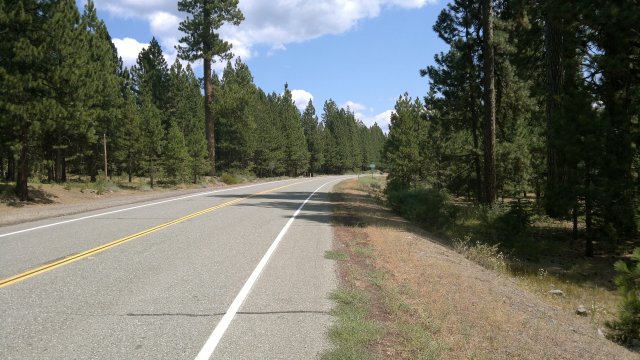
Highway 36 near Lassen National Park Headquarters. About a mile of highway necessary between 31N17 and west end of highway 172, which is a very quiet paved road. Adequate hard shoulder and open sightlines, hence low danger.
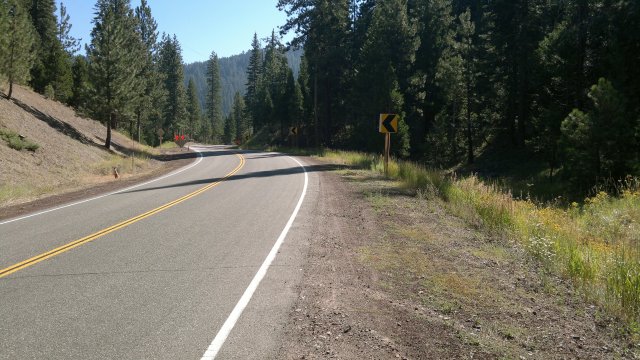
Highway 36/89 near Mill Creek. About a half-mile of highway necessary between east end of highway 172 and 29N25A/28N88. Narrow hard shoulder, but wide soft shoulder, hence low danger. Ride or push on the soft shoulder if you feel unsafe.
Local Bike Shops
- Bicycle Bananas in Susanville. I last visited this local bike shop in 2012 and talked to the owner and can recommend it as having a competent service department. However, it appears closed as of 2015, based on internet research.
- Bodfish Bicycles in Chester. I last visited this local bike shop in 2014 and talked to the owner and can recommend it as having a competent service department.
- RoopTown Bicycles in Susanville. I obtained this address from the Lassen County tourism guide, but did not visit the shop myself.
- Quincy Bike Shop, Lawrence and Leonard Streets, 530-283-4015. I obtained this address from the Plumas County tourism guide, but did not visit the shop myself.
- Mountain Hardware in Blairsden (near Portola) has bike stuff, 530-836-2589. I obtained this address from the Plumas County tourism guide, but did not visit the shop myself.
- Dangerous Sports in Burney supposedly does bike repairs, 530-335-3111. I obtained this information from the manager at the motel where I stayed in Burney, but did not visit the shop myself.
Connectivity
ATT has strong 3G service in Susanville, Chester, Westwood, Greenville, Taylorsville, Burney. No service in Old Station as of 2014 for prepaid phones.
Public libraries in both Chester and Susanville offer free wireless, both when open and after hours. Most motels offer wireless as well.
Lodging information
Prices below are for single occupancy and do NOT include 10% tax.
- Burney - Charm Motel, 530-335-3300, 530-335-2254, $90 according to 2015 website.
- Burney - Green Gables Motel, 530-335-3300, 866-931-0420, $90 according to 2015 website. Same owners and Charm Motel and also Hi-Mont Motel in Fall River Mills.
- Burney - Burney Motel, 530-335-4500, quoted me $82 in Aug 2016, not sure if that price includes 10% tax or not.
- Burney - Shasta Pines Motel, 530-335-2201. Paid $79 in Aug 2016, via reservation through motel website. Higher price if using booking.com or other reservation sites or if reserving by telephone.
- Burney - Sleepy Hollow Lodge, 530-335-2285. Quoted me $65 in August 2013. On the west side of town, far from the grocery store. All the other motels are close to the grocery store.
- Canyon Dam - Quail Lodge Lake Almanor. 530-284-0861.
- Chester - Antlers Motel, 530-258-2722. $80 according website in Oct 2015.
- Chester - Best Western, 530-258-2022, $117 according to website Oct 2015.
- Chester - Bidwell House Bed and Breakfast, 530-258-3338. $85 to $175 according to 2012 tourist office brochure.
- Chester - Seneca Motel, 530-258-2815. Paid $56 in Aug 2015.
- Chester - Manor Motel, 530-258-2441. $89 according to yelp review.
- Chester - Cinnamon Teal Bed and Breakfast, 530-258-3993.
- Chester - Cedar Lodge. 530-258-2904. 2 miles west of town center, intersection of highways 36 and 89. $59-$64 for queen room, according to website Oct 2015.
- Fall River Mills - Hi-Mont Motel, 530-336-5541, 855-877-3883. $80 according to 2013 website.
- Fall River Mills - Fall River Hotel, 530-336-5550.
- Fall River Mills - Fall River Lodge, 530-336-5678. $60/$71 single/double weekdays, $67/$83 weekends, according to website Oct 2015.
- Greenville - Hideaway Motel and Lodge, 530-284-7915, $70 to $95 according to 2012 tourist office brochure.
- Greenville - Sierra Lodge, 530-284-6154. Paid $55 in July 2013. Necessary to carry bike up narrow staircase and room not very large. Okay for solo bike tourist. Couple would need to arrange with manager to store bicycles outside of room somewhere.
- Greenville - Oak Grove Motor Lodge (a mile south of town via dangerous highway 89, so not recommended due to location), 530-284-6671, $65 to $120 according to 2012 tourist office brochure.
- Lassen National Park - Drakesbad Guest Ranch, 866-999-0914, $155 to $179 (all meals included) according to 2012 tourist office brochure.
- Loyalton - Golden West Dining / Motel, 530-993-4467. $63 according to website Oct 2015.
- Loyalton - Gilded Drifter Inn, 916-832-0055. $50 according to listing on AirBnb as of Oct 2017.
- Mineral - Lassen Mineral Lodge, 530-595-4422 (Highway 36 @ Highway 172, small hamlet of Mineral). Motel plus restaurant plus small store. $85 according to 2013 website.
- Susanville - Apple Inn, 530-257-4726. Paid $45 in July 2013.
- Susanville - Best Western, 530-257-4123. $80 to $129 according to 2012 tourist office brochure.
- Susanville - Budget Host Frontier Inn Motel. 530-257-4141. $50 according to 2013 website.
- Susanville - Diamond Mountain Casino Hotel, 530-252-1100, 877-319-8514. $86 to $149 according to 2012 tourist office brochure.
- Susanville - Diamond View Motel, 530-257-4585. Paid $40 in August 2012.
- Susanville - High Country Inn, 530-257-3450, 866-454-4566. $84 to $100 according to 2012 tourist office brochure.
- Susanville - Knights Inn Motel, 530-257-6577. Quoted $49 when I called in August 2012.
- Susanville - River Inn Motel, 530-257-6051. I paid $64 in Oct 2017.
- Susanville - Roseberry House Bed and Breakfast. 530-257-5675.
- Susanville - Super 8 Motel, 530-257-2782, 800-800-8000. $72 to $82 according to 2012 tourist office brochure.
- Susanville - Travel Inn, 530-252-1601. Paid $45 in September 2013. Manager said lower rates available for repeat customers and long-term stays (weeklies, monthlies).
- Westwood - Walker Mansion Inn Bed and Breakfast, 530-256-2169. Center of town.
- Westwood - Villa Monte Motel, 530-256-3493. On highway 36, a mile from center of town. Appears closed as of Aug 2016.
Other Services
- Chester: laundromat along main road in center of town has pay shower next door.
- Eagle Lake: mini-mart has pay showers.
- Taylorsville: pay showers at the campground.
Water sources
Area is dry in summer, so be wary of relying on natural sources. A cyclist pedaling uphill can easy go through 6 to 8 liters/day in hot weather, so I advise 23 liters capacity, to allow at least 3 nights of camping between resupply points. For example, four 6 liter MSR Dromedary bladders in the panniers plus some water bottles in the front triangle. (Dromedaries cannot be filled to the top without spilling, so actual capacity of the 6 liter size is about 5.5 liters). Make sure your urine runs clear at least once per day. Kidney stones are painful—I'm speaking from experience here.
- Loyalton: town park.
- Taylorsville: county campground just outside town.
- Greenville: town park.
- Chester: town park, public library.
- Westwood: town park.
- Susanville: various town parks.
- Old Station: ranger's station or Subway cave.
- Eagle lake: campgrounds.
- Humbug summit: cold springs is a piped spring that supposedly runs year-round.
- Warner valley/Drakesbad resort: campground.
- Bogard Rest area on highway 44. Open in summer 2012 and 2013, but closed in summer 2014 due to drought. However, I was able to get water in 2014 from the Bogard Work Center across the highway.
- Goumaz campground along Bizz Johnson trail: faucets on in summer 2012 and 2013, off in 2014 due to drought, on in 2015 and 2016. Campground lacks staff, so no guarantees as to water availability here.
- National Park Headquaters, along highway 36 west of park.
- Calfire station at Grasshopper road, just north of Eagle lake: occupied through at least end of September, according to staff when in inquired in 2013.
- Many year-round streams running down west side of Mount Lassen and crossing dirt roads there.